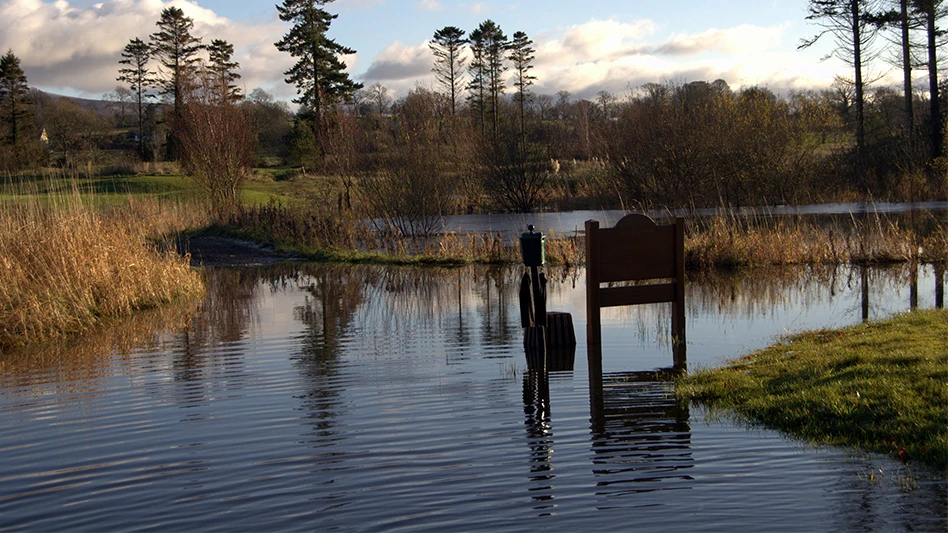

I am neither a weatherman nor a climatologist. But I am a trained social scientist, and while my doctorate is not directly relevant to turfgrass, the years I spent studying cultural crisis and political upheaval occasionally come in handy when it comes to the golf industry.
The last few weeks have brought some hellacious weather — and with it thoughts on a growing challenge to golf in general and to superintendents in particular. In Connecticut, where I live, we have lately seen torrential rains, searing temperatures and haze, and smoke so thick from our Canadian neighbors to the northwest that it’s dangerous simply to go outside and breathe.
Courses throughout Vermont, across western Massachusetts, and into the lower reaches of upstate New York saw flash floods and widespread closures thanks to 6 to 8 inches of rain in several hours.
Meanwhile, across the Southwest and well into the South, a heat wave has brought temperatures steadily into the triple digits. The heat wave has raised water temperatures in the Gulf of Mexico and on the Atlantic Ocean waters off Florida by 5 to 8 degrees above normal — potentially catastrophic for marine life.
It’s gotten to the point where it’s no longer clear what “normal” means. What an interesting math dilemma for The Weather Channel, for instance, when its correspondents must explain that a 100-year storm does not mean once every century; it means a 100-to-one chance of occurring in any given year — which is now every decade, if not more often.
A few years ago, it became evident to me that the slow, inexorable creep of an altered climate was bringing new demands onto golf course managers. I saw this with the proliferation of renovation work at courses that focused simultaneously on drought management and storm water management. In other words, courses needed to adapt their infrastructure to handle more severe weather events at both ends of the water spectrum: protracted shortfalls of rainfall and a measurable increase in major rain events exceeding 2 to 3 inches in a day.
At the same time, across the cool-season regions of the East, Midwest and Pacific Northwest, the golf season has been getting longer. I grew up on Long Island, and during winters in the 1960s, we could often — not always — find frozen ponds to skate on. Good luck with that now.
The warming trend is discernible as well in the elongation of the golf calendar. It’s not a uniformly steady trend; rather, one marked by fits and starts and all sorts of irregularities but nonetheless palpable in the long run, looking back, say, 30 to 40 years.
There is more early golf in late winter and early spring. At the other end of the calendar, there used to be an effective end to the golf season by early November. Now, golf can reliably be played well past Thanksgiving.
The longer golf season is a boon to the golf industry. But the heat of mid-season, what is sometimes termed “100 days of hell,” now borders on scorched earth. It’s not just a matter of courses as far north as Baltimore using Bermudagrass. Turfgrasses can adapt, but golf course workers are another matter. As if the labor shortage in both trained and casual personnel were not already serious enough, the situation is going to get a lot worse because working outdoors these days is increasingly stressful, if not outright dangerous to one’s health.
Any workers with skills involving tools, machinery, labor, and discipline are more likely to opt for work indoors rather than outdoors. This is going to make life very difficult for superintendents when it comes to recruiting a reliable labor force. It is also going to make the industry even more reliant on laborers coming from traditionally warmer climates — presuming labor immigration policy relaxes enough to allow that to occur. Given current impasses in Congress on everything else that is significant, there is no good reason to think progress on this front is likely.
All of which tells me that the job superintendents execute is getting tougher. All the training, the labor-saving technology, the scientific understanding of cultural practices — all of that comprises valuable tools.
The point of appreciating climate, as distinguished from mere transitory weather, is to understand the structural constraints in which one operates. Addressing that will take broader initiatives of national and international policy. Forward-thinking superintendents can help things if they started making allies to address climate on a broad, long-term basis. As I learned from my 14 years as a college professor, that process starts with thinking differently about one’s place in the world.
Get curated news on YOUR industry.
Enter your email to receive our newsletters.
Explore the August 2023 Issue
Check out more from this issue and find your next story to read.
Latest from Golf Course Industry
- SiteOne releases new herbicide
- Bernhard Academy launches new online leadership, management courses
- Nufarm opens 2025 early order program
- Atlanta Athletic Club’s equipment ace
- PBI-Gordon announces 2025 Ryder Cup grounds crew sponsorship
- RISE convenes for 35th annual meeting
- Trust the process
- Envu’s Durentis Insecticide now on fertilizer






